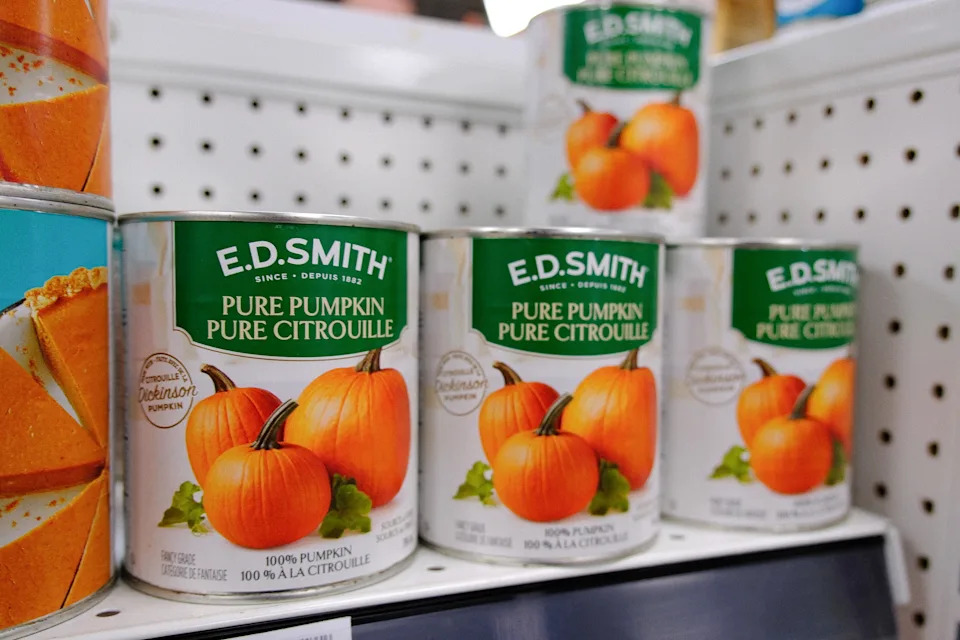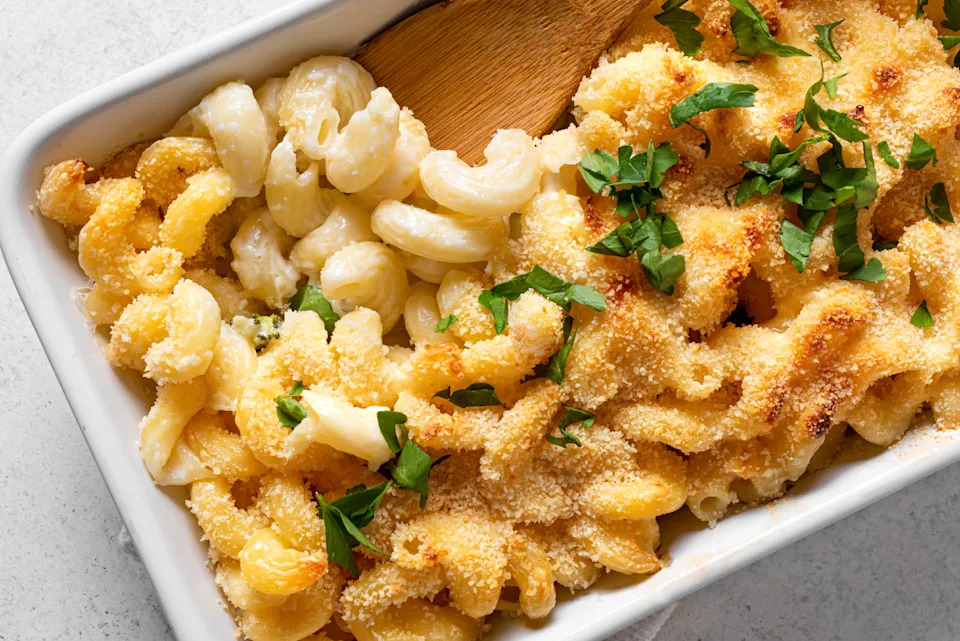Emily Lawrence is finding the cure to her perfectionism inside a can of pumpkin puree, one tablespoon at a time. The recipe developer and creator of the newsletter Home Body Bake Club loves pumpkin for its quintessential autumn vibes.
“As soon as there’s a little bit of chill in the air, I want cinnamon, I want nutmeg, I want cloves. I want all those cozy spices, and I want to start eating fall treats,” she tells Yahoo Canada from Dartmouth, N.S.
But lately, she’s also been focusing on low-lift ways to make the most of the squash that’s a harbinger of the colder months. Some of those include straightforward recipes like a chocolate-pumpkin pudding that comes together in a blender, or a DIY twist on a pumpkin spice latte.
“I’m trying to work on my perfectionism, to be frank,” she adds. “And just showing that something can be simple. It doesn’t need to be fancy or fussy, but it can still be really good.”
The good news? Even if you’d never call yourself a perfectionist, there’s still a place for canned pumpkin in your kitchen. Surprisingly nutrient-dense, this ready-to-use ingredient is healthy and inexpensive — a boon to anyone looking to keep food costs under control during a time when grocery store receipts can make your eyes water.
“Canned pumpkin is so much more than pumpkin pie, and it’s so much more than autumn baking. There’s just so many ways to use it. It’s a pretty neutral ingredient,” Lawrence, who’s been working with said ingredient since the age of 12 at her parent’s bakery, notes.
Here, she breaks down why canned pumpkin is an overlooked pantry MVP — and a great way to celebrate seasonal eating.
Canned pumpkin is so much more than pumpkin pie, and it’s so much more than autumn baking.
Emily LawrenceIs canned pumpkin healthy?
So long as you’re choosing canned pumpkin without added sugar (the ingredients list should only say pumpkin), you’re making a healthy choice. For maximum health values and culinary versatility, reach for options labelled “pumpkin puree” or “100 per cent pure pumpkin.” Try staying away from “pumpkin pie filling,” which will be pre-sweetened.
Low in fat, calories, sugar and salt, pumpkin provides seven grams of fibre per cooked cup, a vital nutrient that most Canadians aren’t eating nearly enough of, according to Heart and Stroke Canada. High in Vitamin B6, C and E, that same serving of pumpkin also offers a whopping 250 per cent of the daily recommended value of Vitamin A, which helps with immune system functioning.
Pumpkin is also high in potassium. This nutrient helps control blood pressure, something one in four Canadians struggle with, according to Hypertension Canada’s 2024 numbers.

If you’re grocery shopping for canned pumpkin, aim for products that are labelled as “pumpkin puree” or “100% pure pumpkin.” (Photo by Chris Stoodley/Yahoo Canada)
Why should I try cooking with canned pumpkin?
The convenience factor of canned pumpkin — as in, the fact that it’s already cooked and ready to use in a host of recipes — is one reason the ingredient is worth trying. But, for once, convenience isn’t going head to head against quality.
“I would never make pumpkin puree by myself,” Lawrence says, explaining that the moisture level and smoothness of canned pumpkin is more consistent than prepping your own pumpkin puree from scratch.
Food writers like Alison Roman and the team at New York Times Cooking back Lawrence up on this one, with most high-quality pumpkin recipes calling for a can of pumpkin puree.
Then there’s the seasonality aspect. In food writer Ruby Tandoh’s 2018 book, Eat Up! Food, Appetite and Eating What You Want, the author waxes poetic about how seasonal eating isn’t just about noticing the newest arrivals at the produce stand. It’s also reaching for foods tied to certain holidays and times of year, even if they come in a can or box.
In this sense, canned pumpkin is perfect for embracing autumn and all that comes after: “All I have to do is just dig to the back of my cupboard, find my pumpkin spice and then suddenly I’m eating autumnally,” adds Lawrence.
How do I cook with canned pumpkin?
There’s a litany of sweet-skewing uses for canned pumpkin: “The most obvious answers would be pumpkin muffins, pumpkin loaves and pumpkin pie, of course, probably my favourite pumpkin dessert,” lists Lawrence.
She also offers two easy recipes that’ll satisfy your sweet tooth and your pumpkin cravings — both offerings from her online series of more realistic meals, which she calls “Struggle Snacks.” Here, she shares them with us.
Recipe: Emily Lawrence’s Pumpkin Chocolate Pudding
1 cup full-fat coconut milk
Add all ingredients to a blender, then blend until smooth and combined. Cover and chill for at least two hours. To serve, portion into small bowl and, if desired, top with a dollop of coconut milk sweetened to taste and a handful of pumpkin seeds.
Recipe: Emily Lawrence’s Pumpkin Spice Shaken Espresso
2 tsp white or brown sugar
To a large jar with a lid, add all ingredients except milk and ice. Attach lid tightly and shake jar vigorously until mixture is combined. Pour over ice, top with milk of choice and serve.

Think canned pumpkin is only for desserts? It can actually be a great addition to savoury meals like mac and cheese. (Photo via Getty Images)
She also adds that a couple tablespoons of pumpkin can be a flavour-and-nutrient dense addition to plain yogurt or chia pudding, along with some pumpkin pie spices, for a taste of fall at breakfast.
But, as mentioned, canned pumpkin can also swerve savoury more often than you’d think: Lawrence suggests adding pumpkin puree to mac and cheese, or even making a simple pasta sauce of pumpkin puree with coconut milk and cooked onions and garlic. She also adds that some people swap canned pumpkin for tomatoes in barbecue sauces and chilis if they’re allergic to nightshades (a family of plants that includes tomatoes, eggplants and peppers).
How can I save money by using canned pumpkin?
Clocking in at around $6 per can at full price, canned pumpkin is one of the most affordable ways to sneak more vegetables (er, technically it’s a fruit, but that’s beside the point here) into your diet. Also, Lawrence mentions that standard brand pumpkin tends to be less watery and more flavourful than its pricier organic counterparts, which feels like another budget win.
Another aspect of keeping food costs in check is, of course, minimizing food waste, something to bear in mind as many cans of pumpkin are just under 800 millilitres. Using up the last few tablespoons in a can is easier than you think.
Aside from Lawrence’s recipes above, you can add some pumpkin puree to homemade Rice Krispies treats for a fall twist, or stir some into hummus for a change in flavour. Add some pumpkin puree to a homemade soup or curry to avoid waste, or even consider smearing pureed pumpkin flavoured with some sage and salt on your favourite pizza base, instead of tomato sauce. Topped with cheese and perhaps some greens, it’ll be a seasonal slice!
From coffee drinks to chili night, canned pumpkin proves it’s a versatile and healthy choice that brings the best of fall to your plate. “It’s great to be able to have something in your pantry that you can rely on,” adds Lawrence. “[Something] that is inexpensive, again, consistent, and that you can use in so many ways — and is quite nutritious.”
Let us know what you think by commenting below and tweeting @YahooStyleCA! Follow us on Twitter and Instagram.


Dining and Cooking